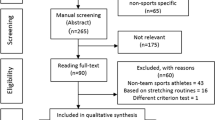Abstract
Tennis injuries have been associated with serving mechanics, but quantitative kinematic measurements in realistic environments are limited by current motion capture technologies. This study tested for kinematic differences at the lower back, shoulder, elbow, wrist, and racquet between the flat, kick, and slice serves using a markerless motion capture (MMC) system. Seven male NCAA Division 1 players were tested on an outdoor court in daylight conditions. Peak racquet and joint center speeds occurred sequentially and increased from proximal (back) to distal (racquet). Racquet speeds at ball impact were not significantly different between serve types. However, there were significant differences in the direction of the racquet velocity vector between serves: the kick serve had the largest lateral and smallest forward racquet velocity components, while the flat serve had the smallest vertical component (p < 0.01). The slice serve had lateral velocity, like the kick, and large forward velocity, like the flat. Additionally, the racquet in the kick serve was positioned 8.7 cm more posterior and 21.1 cm more medial than the shoulder compared with the flat, which could suggest an increased risk of shoulder and back injury associated with the kick serve. This study demonstrated the potential for MMC for testing sports performance under natural conditions.








Similar content being viewed by others
References
Chow, J. W., L. G. Carlton, Y. T. Lim, W. S. Chae, J. H. Shim, A. F. Kuenster, and K. Kokubun. Comparing the pre- and post-impact ball and racquet kinematics of elite tennis players’ first and second serves: a preliminary study. J Sports Sci 21(7):529–537, 2003.
Corazza, S., E. Gambaretto, L. Mundermann, and T. P. Andriacchi. Automatic generation of a subject-specific model for accurate markerless motion capture and biomechanical applications. IEEE Trans. Biomed. Eng. 57(4):806–812, 2010.
Corazza, S., L. Mundermann, A. M. Chaudhari, T. Demattio, C. Cobelli, and T. P. Andriacchi. A markerless motion capture system to study musculoskeletal biomechanics: Visual hull and simulated annealing approach. Ann. Biomed. Eng. 34(6):1019–1029, 2006.
Corazza, S., L. Mundermann, E. Gambaretto, G. Ferrigno, and T. P. Andriacchi. Markerless motion capture through visual hull, articulated icp and subject specific model generation. Int. J. Comput. Vis. 87(1–2):156–169, 2010.
Elliott, B. Spin and the power serve in tennis. J. Human Mov. Stud. 9(2):97–104, 1983.
Elliott, B., and J. Alderson. Laboratory versus field testing in cricket bowling: a review of current and past practice in modelling techniques. Sports Biomech. 6(1):99–108, 2007.
Elliott, B., G. Fleisig, R. Nicholls, and R. Escamilia. Technique effects on upper limb loading in the tennis serve. J. Sci. Med. Sport 6(1):76–87, 2003.
Elliott, B., T. Marsh, and B. Blanksby. A 3-dimensional cinematographic analysis of the tennis serve. Int. J. Sport Biomech. 2(4):260–271, 1986.
Elliott, B. C., R. N. Marshall, and G. J. Noffal. Contributions of the upper-limb segment rotations during the power serve in tennis. J. Appl. Biomech. 11(4):433–442, 1995.
Fleisig, G., R. Nicholls, B. Elliott, and R. Escamilla. Kinematics used by world class tennis players to produce high-velocity serves. Sports Biomech. 2(1):51–64, 2003.
Gordon, B. J., and J. Dapena. Contributions of joint rotations to racquet speed in the tennis serve. J. Sports Sci. 24(1):31–49, 2006.
Hill, J. A. Epidemiologic perspective on shoulder injuries. Clin. Sports Med. 2(2):241–246, 1983.
Johnson, C. D., and M. P. McHugh. Performance demands of professional male tennis players. Br. J. Sports Med. 40(8):696–699, 2006.
Kibler, W. B., and M. Safran. Tennis injuries. Med. Sport Sci. 48:120–137, 2005.
Knudson, D., and R. Bahamonde. Effect of endpoint conditions on position and velocity near impact in tennis. J. Sports Sci. 19(11):839–844, 2001.
Marks, M. R., S. S. Haas, and S. W. Wiesel. Low-back pain in the competitive tennis player. Clin. Sports Med. 7(2):277–287, 1988.
Marshall, R. N., and B. C. Elliott. Long-axis rotation: the missing link in proximal-to-distal segmental sequencing. J. Sports Sci. 18(4):247–254, 2000.
McCann, P. D., and L. U. Bigliani. Shoulder pain in tennis players. Sports Med. 17(1):53–64, 1994.
Mundermann, L., S. Corazza, and T. P. Andriacchi. The evolution of methods for the capture of human movement leading to markerless motion capture for biomechanical applications. J. Neuroeng. Rehabil. 3(1):article 6, 2006.
Reid, M., B. Elliott, and J. Alderson. Shoulder joint loading in the high performance flat and kick tennis serves. Br. J. Sports Med. 41(12):884–889, 2007.
Reid, M., B. Elliott, and J. Alderson. Lower-limb coordination and shoulder joint mechanics in the tennis serve. Med. Sci. Sports Exerc. 40(2):308–315, 2008.
Sigal, L., and M. J. Black. Guest editorial: state of the art in image- and video-based human pose and motion estimation. Int. J. Comput. Vis. 87(1–2):1–3, 2010.
Sprigings, E., R. Marshall, B. Elliott, and L. Jennings. A 3-dimensional kinematic method for determining the effectiveness of arm segment rotations in producing racquet-head speed. J. Biomech. 27(3):245–254, 1994.
Tanabe, S., and A. Ito. A three-dimensional analysis of the contributions of upper limb joint movements to horizontal racket head velocity at ball impact during tennis serving. Sports Biomech. 6(3):418–433, 2007.
Tennis Industry Association. Executive summary 2008. The tennis marketplace. 9:1–16, 2008.
Vorobiev, A., G. Ariel, and D. Dent. Biomechanical similarities and differences of A. Agassi’s first and second serves. In: Proceedings of the 11 International Symposium on Biomechanics in Sports, 1993.
Acknowledgments
The authors would like to acknowledge Katerina Blazek, Nathan Fenner, Julien Farve, Yoshimori Kiriyama, and all of the Biomotion Lab members that donated their time to collect this data.
Conflict of interest
There were no conflicts of interests associated with this research.
Author information
Authors and Affiliations
Corresponding author
Additional information
Associate Editor Michael R. Torry oversaw the review of this article.
Rights and permissions
About this article
Cite this article
Sheets, A.L., Abrams, G.D., Corazza, S. et al. Kinematics Differences Between the Flat, Kick, and Slice Serves Measured Using a Markerless Motion Capture Method. Ann Biomed Eng 39, 3011–3020 (2011). https://doi.org/10.1007/s10439-011-0418-y
Received:
Accepted:
Published:
Issue Date:
DOI: https://doi.org/10.1007/s10439-011-0418-y




